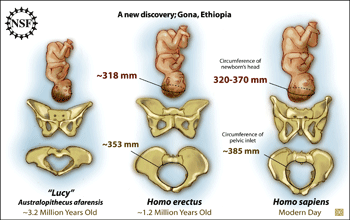Multimedia Gallery
Pelvic-bone Comparison
Three sets of pelvic bones (both a side view and top view) are shown, along with the approximate size of full-term fetus they could handle. On the left is the pelvis and baby of "Lucy," the Australopithecus afarensis from 3.2 million years ago. In the middle is the newly discovered pelvis of 1.2 million year old Homo erectus. And on the right is the pelvis and baby of a modern day female human being, or Homo sapiens. Homo erectus was previously thought to produce babies with relatively small brain capacity. However the discovery of the pictured pelvis has shown that they were actually capable of birthing babies with a cranial circumference very close to the lower end of the range of our own species. The Homo erectus shown could have produced a baby with a cranial circumference of 318 mm, while modern day babies vary from 320 to 370 mm.
This image accompanied NSF press release, "Discovery Questions Intelligence of Human Ancestor."
Credit: Zina Deretsky, National Science Foundation
Images and other media in the National Science Foundation Multimedia Gallery are available for use in print and electronic material by NSF employees, members of the media, university staff, teachers and the general public. All media in the gallery are intended for personal, educational and nonprofit/non-commercial use only.
Images credited to the National Science Foundation, a federal agency, are in the public domain. The images were created by employees of the United States Government as part of their official duties or prepared by contractors as "works for hire" for NSF. You may freely use NSF-credited images and, at your discretion, credit NSF with a "Courtesy: National Science Foundation" notation.
Additional information about general usage can be found in Conditions.
Also Available:
Download the high-resolution JPG version of the image. (943 KB)
Use your mouse to right-click (Mac users may need to Ctrl-click) the link above and choose the option that will save the file or target to your computer.

